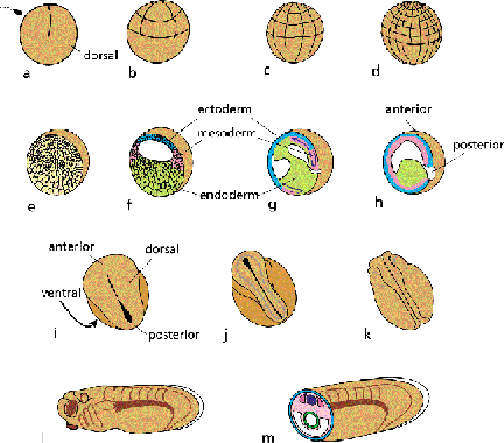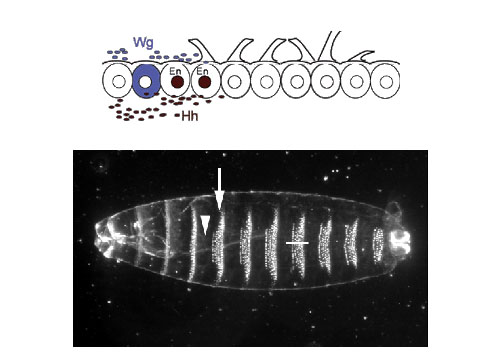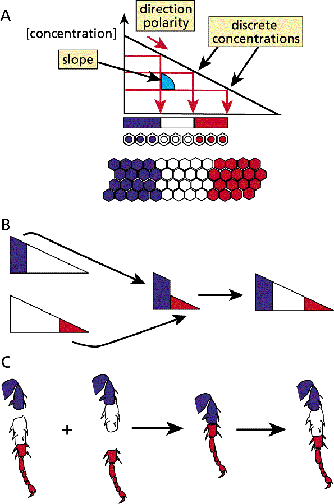
Lecture 1
Introduction to Gene Regulation in Development
It is my intention here to provide a brief overview of how we think development occurs, and to list some of the problems that remain to be solved. The following is taken from Wolpert's Principles of Development.
1. Development involves cell division, the emergence of pattern, change in form, cell differentiation and growth.
Development is the emergence of organized structures from a single cell, the fertilized egg. Fertilization is proceeded by a period of rapid cell division. Pattern formation is the process by which a spatial and temporal pattern of cell activities is organized within the embryo, so that a well-ordered structure develops. Pattern formation initially requires laying down the overall body plan and establishing the primary axes: anterior-posterior (A/P), dorsal-ventral (D/V) and left-right (L/R). Part of the course will be spent on this aspect of development.
The next stage in pattern formation is the allocation of cells to different germ layers: the ectoderm, mesoderm and endoderm. During further pattern formation, the cells within these layers acquire different identities, so that organized patterns of cell differentiation emerge. Part of our time will be spent here.
The next major step is the change in form, or morphogenesis. We recognize development because we see three dimensional complexities in form. We spend very little time on this aspect of development.
A fourth major step is cell differentiation, in which cells become different from each other. Differentiation is a gradual process and stems from differential gene expression. Although this course is about differential gene expression, we will examine this aspect of development only as it pertains to how genes are regulated.
The fifth major step is growth. We now understand a great deal about the regulation of the cell cycle, but that is a course in its own right and will not be discussed.
These five processes are neither independent nor strictly sequential.

Martinez Arias and Stewart. Molecular Principles of Animal Development.
*Though differentiated cells become more specialized during development, they retain their genetic potential. As shown by nuclear transplantation experiments.

2. Cell behaviour provides the link between gene action and developmental processes.
Gene expression within cells is translated into embryonic development through changes in the properties of cells. These include changes in gene activity, cell-to-cell signalling, changes in cell shape and movement, changes in proliferation and apoptosis (cell death). Changes in cells are key to development.

Wingless Signal Transduction Pathway
3. Genes control cell behaviour by controlling which proteins are made by a cell.
The genome of an organism contains all the information to generate all the proteins of that organism. A cell's function is largely controlled by the proteins in it. Each specialized cell type (about 250 in the human body) has approximately 50 proteins that are unique to it. These unique expression profiles give the cell type its character. This is why the major problem in development is to figure out how genes are regulated. In this course we are going to concentrate on the mechanisms of transcriptional regulation.

4. Development is progressive.
As development proceeds, the organizational complexity of the embryo becomes vastly increased. In general, the embryo is first divided into broad regions and then subsequently refined. Determination implies a stable change in the internal state of a cell. The fate of a group of cells describes what they will normally develop into. Fates are specified in two main ways. One is that the cell inherits a signal asymmetrically so that one daughter cell has the signal and one does not. The other is that neighbouring cells change the fate by passing a signal, which eventually gets interpreted by the nucleus as a change in gene expression.
5. Patterning requires positional information.
Cells need to know where they are relative to other cells in the embryo if they are to do the right thing, in the right place. Much of early development consists in the elaboration of a coordinate system of conveying positional information to cells. The major idea about positional information is that some molecule is present in a concentration gradient called a morphogen, and the change in morphogen concentration conveys information about position. Essential to this idea is that at different thresholds of concentration, different cells, and as we will see, different enhancers that regulate genes, respond differently, thus changing cell fate in a position-dependent way. An essential part of this course is to realize how enhancers translate morphogen gradients into spatially regulated gene expression.

Martinez Arias and Stewart. Molecular Principles of Animal Development.
The French flag analogy provides a useful model to illustrate the concept of the morphogen gradient.